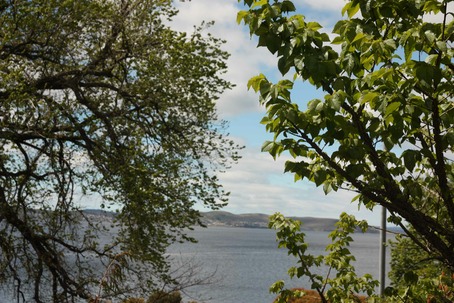There are a couple of routes that link Salamanca and Battery Point, and we’d used one of them, Montpelier Retreat, when we made our way from where we’d parked to the markets on Saturday, so we weren’t inclined to retrace our steps that way.
Around two-thirds of the way along the Salamanca warehouses there’s a sign directing you towards Kelly’s Steps, constructed by sealer, pilot and harbourmaster James Kelly in 1839 with the express purpose of connecting Battery Point and Salamanca Place. Before the steps went in, Battery Point sat atop a cliff overlooking Salamanca and the steps were cut into the cliff face as part of the quarrying process that provided sandstone for the Salamanca warehouses.
While we didn’t go that way in the morning, I’d noted the fact that the steps lead up to Kelly Street, which then takes you on to Hampden Road and the Battery Point restaurant strip. That was the location we’d been looking to visit the previous night. Figuring the knowledge would come in useful I tucked this snippet away in the memory bank.
We headed along Salamanca, past Salamanca Terraces and Lenna of Hobart, the National Trust and Tasmanian Heritage Register listed restored sandstone mansion that operates as a luxury hotel. Lenna was built by Alexander McGregor, a ship builder turned merchant who built the largest fleet of individually owned sailing ships in the southern hemisphere as Hobart became the centre of a shipbuilding and whaling industry.

Just after Lenna you encounter Princes Park, which takes its name from the second incarnation of the artillery battery that gives the Point its name. It was initially installed in 1818 to protect Hobart from invasion and French or Russian raiders.
That was the Mulgrave Battery, named after the first Earl of Mulgrave, Master General of the King's Ordnance. With earth ramparts and cannons from a ship, the battery was permanently manned by soldiers. It fired a salute on the Prince of Wales' birthday in 1818, but failed to notice the Young Lachlan, stolen by 13 convicts, when it sailed past the battery unobserved in March 1819. It was renamed the Prince of Wales Battery in 1855.
In the meantime, a second battery, the Prince Albert Battery had been installed further up the hill in 1841. All very well in theory, but reading the information panels in the park it seems the city’s defences were, to all intents and purposes, a joke and it’s just as well the French and Russians failed to arrive on the doorstep.